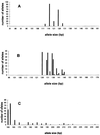Analysis of microsatellite markers of Candida albicans used for rapid typing
- PMID: 11682532
- PMCID: PMC88489
- DOI: 10.1128/JCM.39.11.4076-4081.2001
Analysis of microsatellite markers of Candida albicans used for rapid typing
Abstract
To obtain a rapid genotyping method of Candida albicans, three polymorphic microsatellite markers were investigated by multiplex PCR. The three loci, called CDC3, EF3, and HIS3, were chosen because they are on different chromosomes so as to improve the chances of finding polymorphisms. One set of primers was designed for each locus, and one primer of each set was dye-labeled to read PCR signals by using an automatic sequencer. Amplifications were performed directly from the colonies harvested on the agar plate without a sophisticated DNA extraction step. At total of 27 reference strains and 73 clinical independent isolates were tested. The numbers of allelic associations were 10, 22, and 25 for the loci CDC3, EF3, and HIS3, respectively. The combined discriminatory power of the three microsatellites markers was 0.97. The markers were stable after 25 subcultures, and the amplifications were specific for C. albicans. An initial study of 17 clinical isolate pairs, including blood culture and peripheral sites, showed a similar genotype for 15 of them, confirming that candidemia usually originates from the colonizing isolate. Therefore, microsatellite marker analysis with multiplex PCR and automated procedures has a high throughput and should be suitable for large epidemiologic studies of C. albicans.
Figures
References
-
- Bart-Delabesse E, Sarfati J, Debeaupuis J P, van Leeuwen W, van Belkum A, Bretagne S, Latgé J P. Comparison of restriction fragment length polymorphism, microsatellite length polymorphism, and random amplification of polymorphic DNA analyses for fingerprinting Aspergillus fumigatus isolates. J Clin Microbiol. 2001;39:2683–2686. - PMC - PubMed
-
- Beck-Sagué C M, Jarvis W R National Nosocomial Infections Surveillance System. Secular trends in the epidemiology of nosocomial fungal infections in the United States, 1980–1990. J Infect Dis. 1993;167:1247–1251. - PubMed
-
- Brownstein M J, Carpten J D, Smith J R. Modulation of non-templated nucleotide addition by Taq DNA polymerase: primer modifications that facilitate genotyping. BioTechniques. 1996;20:1004–1010. - PubMed
Publication types
MeSH terms
Substances
LinkOut - more resources
Full Text Sources


